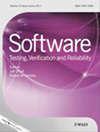Effective fault localization and context‐aware debugging for concurrent programs
IF 1.2
4区 计算机科学
Q3 COMPUTER SCIENCE, SOFTWARE ENGINEERING
引用次数: 2
Abstract
Concurrent programs are difficult to debug because concurrency faults usually occur under specific inputs and thread interleavings. Fault localization techniques for sequential programs are often ineffective because the root causes of concurrency faults involve memory accesses across multiple threads rather than single statements. Previous research has proposed techniques to analyse passing and failing executions obtained from running a set of test cases for identifying faulty memory access patterns. However, stand‐alone access patterns do not provide enough contextual information, such as the path leading to the failure, for developers to understand the bug. We present an approach, Coadec, to automatically generate interthread control flow paths that can link memory access patterns that occurred most frequently in the failing executions to better diagnose concurrency bugs. Coadec consists of two phases. In the first phase, we use feature selection techniques from machine learning to localize suspicious memory access patterns based on failing and passing executions. The patterns with maximum feature diversity information can point to the most suspicious pattern. We then apply a data mining technique and identify the memory access patterns that occurred most frequently in the failing executions. Finally, Coadec identifies faulty program paths by connecting both the frequent patterns and the suspicious pattern. We also evaluate the effectiveness of fault localization using test suites generated from different test adequacy criteria. We introduce and have evaluated Coadec on 10 real‐world multithreaded Java applications. Results indicate that Coadec outperforms state‐of‐the‐art approaches for localizing concurrency faults and that Coadec's context debugging can help developers understand concurrency fault by inspecting a small percentage of code.并行程序的有效故障定位和上下文感知调试
并发程序很难调试,因为并发错误通常发生在特定输入和线程交错的情况下。串行程序的错误定位技术通常是无效的,因为并发性错误的根本原因涉及跨多个线程而不是单个语句的内存访问。以前的研究已经提出了一些技术来分析通过运行一组测试用例来识别错误的内存访问模式而获得的通过和失败的执行。然而,独立的访问模式不能提供足够的上下文信息,例如导致故障的路径,以供开发人员理解错误。我们提出了一种方法Coadec,用于自动生成线程间控制流路径,该路径可以链接失败执行中最常见的内存访问模式,从而更好地诊断并发错误。Coadec包括两个阶段。在第一阶段,我们使用机器学习中的特征选择技术来定位基于失败和通过执行的可疑内存访问模式。特征多样性信息最大的模式可以指向最可疑的模式。然后,我们应用数据挖掘技术,确定在失败执行中最常见的内存访问模式。最后,Coadec通过连接频繁模式和可疑模式来识别错误的程序路径。我们还使用由不同测试充分性标准生成的测试套件来评估故障定位的有效性。我们在10个真实的多线程Java应用程序中介绍并评估了Coadec。结果表明,Coadec在并发错误本地化方面优于最先进的方法,并且Coadec的上下文调试可以帮助开发人员通过检查一小部分代码来理解并发错误。
本文章由计算机程序翻译,如有差异,请以英文原文为准。
求助全文
约1分钟内获得全文
求助全文
来源期刊

Software Testing Verification & Reliability
工程技术-计算机:软件工程
CiteScore
3.70
自引率
0.00%
发文量
34
审稿时长
>12 weeks
期刊介绍:
The journal is the premier outlet for research results on the subjects of testing, verification and reliability. Readers will find useful research on issues pertaining to building better software and evaluating it.
The journal is unique in its emphasis on theoretical foundations and applications to real-world software development. The balance of theory, empirical work, and practical applications provide readers with better techniques for testing, verifying and improving the reliability of software.
The journal targets researchers, practitioners, educators and students that have a vested interest in results generated by high-quality testing, verification and reliability modeling and evaluation of software. Topics of special interest include, but are not limited to:
-New criteria for software testing and verification
-Application of existing software testing and verification techniques to new types of software, including web applications, web services, embedded software, aspect-oriented software, and software architectures
-Model based testing
-Formal verification techniques such as model-checking
-Comparison of testing and verification techniques
-Measurement of and metrics for testing, verification and reliability
-Industrial experience with cutting edge techniques
-Descriptions and evaluations of commercial and open-source software testing tools
-Reliability modeling, measurement and application
-Testing and verification of software security
-Automated test data generation
-Process issues and methods
-Non-functional testing
 求助内容:
求助内容: 应助结果提醒方式:
应助结果提醒方式:


